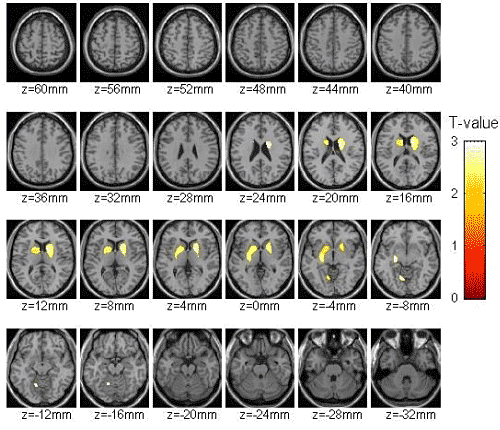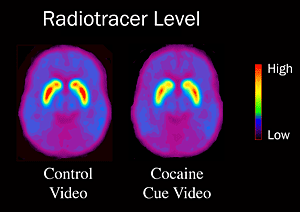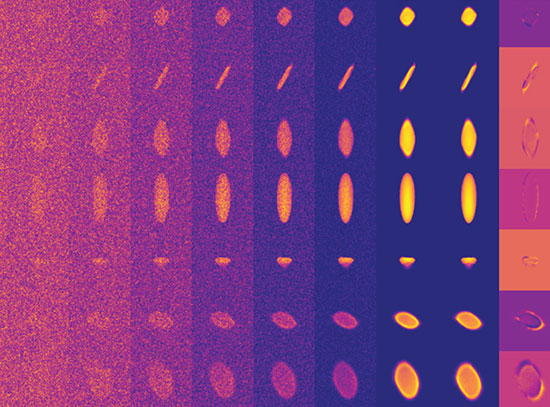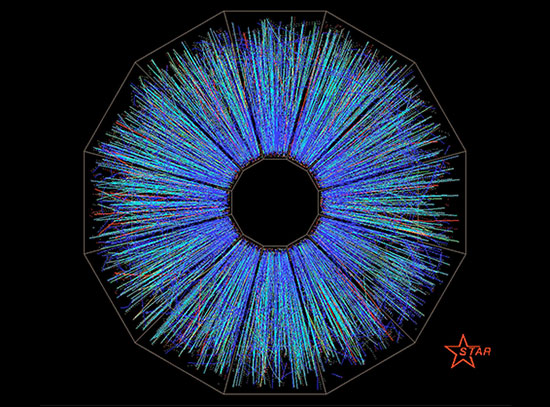Study Reveals Biochemical Signature of Cocaine Craving in Humans
Finding suggests new target for treatments aimed at stopping addiction
June 13, 2006
UPTON, NY - Ask anyone who has been addicted to drugs and they'll tell you that the mere sight of someone using their drug of choice - or even people, places, or objects associated with drug use - can trigger an intense desire for the drug. Using sophisticated brain-imaging techniques at the U.S. Department of Energy's Brookhaven National Laboratory, scientists from the National Institute on Drug Abuse (NIDA), Brookhaven Lab, and the University of Pennsylvania have uncovered the brain chemistry that underlies such "cue-induced" craving in cocaine addicts. The work, which appears in the June 14, 2006 issue of the Journal of Neuroscience, suggests new targets for medications aimed at treating addiction.

Gene-Jack Wang and Nora Volkow.
"Drug craving triggered by cues, such as the sight, smell, and other sensory stimuli associated with a particular drug like cocaine, is central to addiction and poses an obstacle to successful therapy for many individuals," says NIDA Director Nora D. Volkow, lead author on the study and former Associate Laboratory Director for life sciences research at Brookhaven Lab. "Today we can actually see increases in specific brain activities that are linked to this experience. If we can understand the mechanisms related to cue-induced craving, we can develop more effective treatment strategies to counteract it."
Previous research conducted at Brookhaven and elsewhere has shown that all addictive drugs increase the level of dopamine - a neurotransmitter, or chemical messenger, associated with feelings of reward and pleasure - in a part of the brain known as the nucleus accumbens. "This acute reaction in the brain's 'pleasure center' is believed to underlie the reinforcing effects of addictive drugs, but does not explain the intense desire and compulsive use that occurs when addicted subjects are exposed to drug cues," said Gene-Jack Wang, who led Brookhaven's role in the current research.
To probe the role of dopamine in cue-induced craving, the scientists measured dopamine levels in various parts of the brain in 18 cocaine addicts as they watched a "cocaine-cues" video (featuring people buying and using cocaine), and the same 18 subjects as they watched a "neutral" video of natural scenery.

Yellow highlights on these brain images show regions where dopamine levels were significantly elevated in cocaine addicts while watching a "cocaine cues" video compared with levels in the same subjects while watching a "neutral" video of natural scenery. The highlighted regions correspond to the dorsal striatum, an area of the brain associated with desire and motivation.
"To make the drug-cues video, we worked with addicts who advised us on how to make it as realistic as possible while simulating scenes involving smoking or snorting cocaine," said Wang. The scientists also asked the subjects to rate their level of craving while watching both videos, and assessed the severity of their addiction using a standard cocaine craving scale.
Dopamine levels were measured indirectly using positron emission tomography (PET) scanning at Brookhaven's Center for Translational Neuroimaging. Each subject was injected with a radiotracer designed to bind to dopamine receptors in the brain. During scanning, the PET camera picks up the signal from any bound radiotracer so that levels of tracer bound to receptors can be compared with levels in the blood. As the body's natural dopamine levels rise, this "endogenous" dopamine competes with the tracer for binding sites, so less radiotracer can bind to the receptors. Therefore, the lower the bound tracer signal, the higher the concentration of endogenous dopamine.
 enlarge
enlarge
Subjects were injected with a radiotracer that competes with the brain's natural dopamine to bind to dopamine receptors. When brain dopamine levels are high, less tracer can bind to the receptors. In this study, watching the cocaine cues video resulted in a lower bound tracer signal, on average, compared with watching the control video. This indicates that subjects had higher brain dopamine levels, on average, while watching the cues video. (Click image to download hi-res version.)
Compared with the neutral video, the cocaine-cues video triggered a significant increase in dopamine in the dorsal striatum, a part of the brain involved in experiencing desire or motivation. The changes in dopamine were associated with the level of craving reported by the subjects and were largest in the most severely addicted subjects.
This finding is consistent with previous animal studies that have suggested a role for the dorsal striatum in cue-induced craving. In those studies, neutral stimuli such as a particular cage environment that had been paired with a drug during "training" sessions later triggered a dopamine increase in both the nucleus accumbens and the dorsal striatum, a response that was correlated with drug-seeking behaviors in the animals.
The finding is also consistent with earlier Brookhaven research documenting dopamine increases in the dorsal striatum induced by exposure to food (see this release). In that study, healthy subjects were allowed to observe and smell their favorite foods, but not eat them; the more the subjects desired the foods, the higher their dopamine levels went.
"Finding this same association between dorsal striatum dopamine levels and cravings for food and drugs suggests that, in the human brain, drug addiction engages the same neurobiological processes that motivate food-seeking behaviors triggered by food-conditioned cues," Volkow said. This research suggests that compounds that could inhibit cue-induced striatal dopamine increases would be logical targets for medication development to treat cocaine addiction.
This research was funded by the National Institutes of Health Intramural Program (National Institute on Alcohol Abuse and Alcoholism), the Office of Biological and Environmental Research within the U.S. Department of Energy's (DOE) Office of Science, and the National Institute on Drug Abuse.
Brain-imaging studies such as PET are a direct outgrowth of DOE's long-standing investment in basic research in chemistry, physics, and nuclear medicine. The ongoing neuroimaging research at Brookhaven is a prime example of how DOE's national laboratories bring together the expertise of chemists, physicists, and medical scientists to address questions of profound significance for society.
Note to local editors: Gene-Jack Wang lives in Port Jefferson, New York.
2006-10504 | INT/EXT | Newsroom









